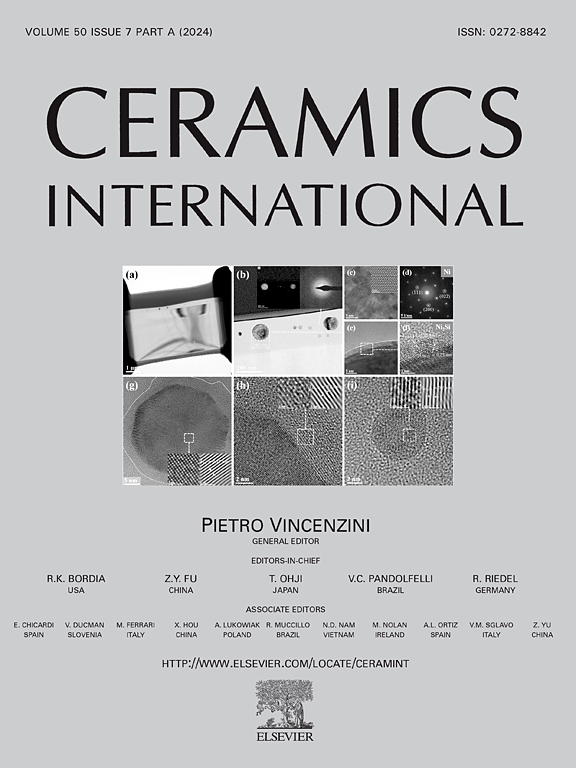利用纳米二氧化硅制备高近红外反射率蓝色颜料CaCuSi4O10
IF 5.6
2区 材料科学
Q1 MATERIALS SCIENCE, CERAMICS
引用次数: 0
摘要
以粒径为384 nm的纳米二氧化硅为原料,合成了近红外高反射率的无机埃及蓝颜料CaCuSi4O10。通过x射线物相分析、扫描电镜和紫外-可见-近红外漫反射光谱对颜料进行了表征。颜色坐标L * a * b *用比色法测定。在1000℃退火后,CaCuSi4O10粉末呈现出强烈的蓝色(L∗= 65.23,a∗= - 5.39,b∗= - 32.53,HEX#66A4D8),近红外太阳反射率为87%。结果表明,CaCuSi4O10颜料作为发光太阳能聚光器(LSC)和冷涂层的有效材料具有很大的应用潜力。本文章由计算机程序翻译,如有差异,请以英文原文为准。
High NIR reflectance blue pigment CaCuSi4O10 prepared by using nanoscale silicon dioxide
The inorganic Egyptian blue pigment CaCuSi4O10, with high reflectance in the near-infrared range, was synthesized using nanoscale silicon dioxide with a particle size of 384 nm. The pigment was characterized by X-ray phase analysis, scanning electron microscopy, and UV–Vis–NIR diffuse reflectance spectroscopy. The color coordinates L∗a∗b∗ were determined using a colorimetric method. After annealed at 1000 °C, the CaCuSi4O10 powder acquired an intense blue color (L∗ = 65.23, a∗ = −5.39, b∗ = −32.53, HEX#66A4D8) and demonstrated near-infrared solar reflectance of 87 %. The obtained results indicate that the CaCuSi4O10 pigment holds significant potential as an effective material for application in luminescent solar concentrator (LSC) and cool coatings.
求助全文
通过发布文献求助,成功后即可免费获取论文全文。
去求助
来源期刊

Ceramics International
工程技术-材料科学:硅酸盐
CiteScore
9.40
自引率
15.40%
发文量
4558
审稿时长
25 days
期刊介绍:
Ceramics International covers the science of advanced ceramic materials. The journal encourages contributions that demonstrate how an understanding of the basic chemical and physical phenomena may direct materials design and stimulate ideas for new or improved processing techniques, in order to obtain materials with desired structural features and properties.
Ceramics International covers oxide and non-oxide ceramics, functional glasses, glass ceramics, amorphous inorganic non-metallic materials (and their combinations with metal and organic materials), in the form of particulates, dense or porous bodies, thin/thick films and laminated, graded and composite structures. Process related topics such as ceramic-ceramic joints or joining ceramics with dissimilar materials, as well as surface finishing and conditioning are also covered. Besides traditional processing techniques, manufacturing routes of interest include innovative procedures benefiting from externally applied stresses, electromagnetic fields and energetic beams, as well as top-down and self-assembly nanotechnology approaches. In addition, the journal welcomes submissions on bio-inspired and bio-enabled materials designs, experimentally validated multi scale modelling and simulation for materials design, and the use of the most advanced chemical and physical characterization techniques of structure, properties and behaviour.
Technologically relevant low-dimensional systems are a particular focus of Ceramics International. These include 0, 1 and 2-D nanomaterials (also covering CNTs, graphene and related materials, and diamond-like carbons), their nanocomposites, as well as nano-hybrids and hierarchical multifunctional nanostructures that might integrate molecular, biological and electronic components.
 求助内容:
求助内容: 应助结果提醒方式:
应助结果提醒方式:


